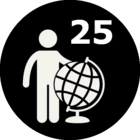is there a way to make sure that data from a shape file transfered to a gdb file using FME have the exact same coordinate values?
I happen to have to rounding happening in some features. This means that when I compare features from the shp and the gdb feature class, there will be some geometry discrepencies flagged up even though there should be.
I don't know when the rounding occurs (i.e. when it's written the first time to the gdb or when it's read the following time from the gdb)
Any idea? Anything I can set on the GDB writer or FeatureReader to make sure this doesn't happen?
Thanks in advance,
Maryse






